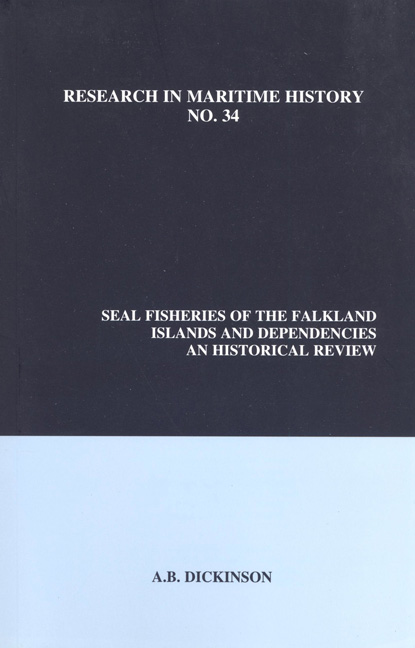Book contents
- Frontmatter
- map
- Contents
- List of Tables in the Text
- List of Illustrations
- About the Author
- Chapter 1 Introduction
- Chapter 2 Unregulated Sealing in the Falkland Islands
- Chapter 3 The Development of a Regulated Industry
- Chapter 4 Unregulated Sealing in the Dependencies
- Chapter 5 Regulated Sealing in the Falkland Islands, 1881-1914
- Chapter 6 Pelagic Sealing
- Chapter 7 Twentieth-Century Sealing on the Falkland Islands
- Chapter 8 Controlled Sealing at South Georgia
- Chapter 9 Aftermath
- Appendices 1-8
Chapter 1 - Introduction
- Frontmatter
- map
- Contents
- List of Tables in the Text
- List of Illustrations
- About the Author
- Chapter 1 Introduction
- Chapter 2 Unregulated Sealing in the Falkland Islands
- Chapter 3 The Development of a Regulated Industry
- Chapter 4 Unregulated Sealing in the Dependencies
- Chapter 5 Regulated Sealing in the Falkland Islands, 1881-1914
- Chapter 6 Pelagic Sealing
- Chapter 7 Twentieth-Century Sealing on the Falkland Islands
- Chapter 8 Controlled Sealing at South Georgia
- Chapter 9 Aftermath
- Appendices 1-8
Summary
The Falkland Islands and Dependencies
The Falkland Islands (51°-52° 40’ S, 57° 30'-61° 31’ W) comprise the large East and West islands and numerous islets some 500 km. northeast of Tierra del Fuego. From east to west the archipelago covers about 240 km., and 150 km. north to south (see figure 1.1). Some 1850 of the approximately 2900 residents live in the capital, Stanley (previously Port Stanley), with the remainder occupying about eighty farm settlements, often close to the sea for ease of access (see figure 1.2).
Although there are well defined historical and legal foundations for British sovereignty over the islands, confusion over ownership existed until 1833 as France, Great Britain, Spain and Argentina (then the United Provinces of Rio de la Plata) established small settlements of short duration. Argentina continues to claim the islands, a policy which culminated in the 1982 conflict with Great Britain. Its claim is partly based on succession to the Spanish Vice- Royalty of Rio de la Plata, which also controlled much of present-day Uruguay, Paraguay, Bolivia and Chile. In 1833, Great Britain assumed full control of the islands. They are now a United Kingdom Overseas Territory and an associated territory of the European Union.
The first European sighting of the Falklands, probably the outlying Jason Islands, may have been by the Italian navigator Amerigo Vespucci in 1502. It was not until 14 August 1592, however, that the first firm European claim was made for Great Britain by Capt. John Davis, master of Desire. Two years later, Admiral Sir Richard Hawkins arrived on Dainty off what are now the Jason Islands, the most northerly in the archipelago. Hawkins was unable to land on what he named “Hawkins’ Maiden Land” in honour of Elizabeth I:
[for] want of our pinnace…together with a change in the wind hindered the further discovery of this land with its secrets; this I have sorrowed for many times since, for that it had the likelihood to be an excellent country… the land was not mountainous and had much of the disposition of England and as temperate.
- Type
- Chapter
- Information
- Seal Fisheries of the Falkland Islands and DependenciesAn Historical Review, pp. 1 - 24Publisher: Liverpool University PressPrint publication year: 2007



